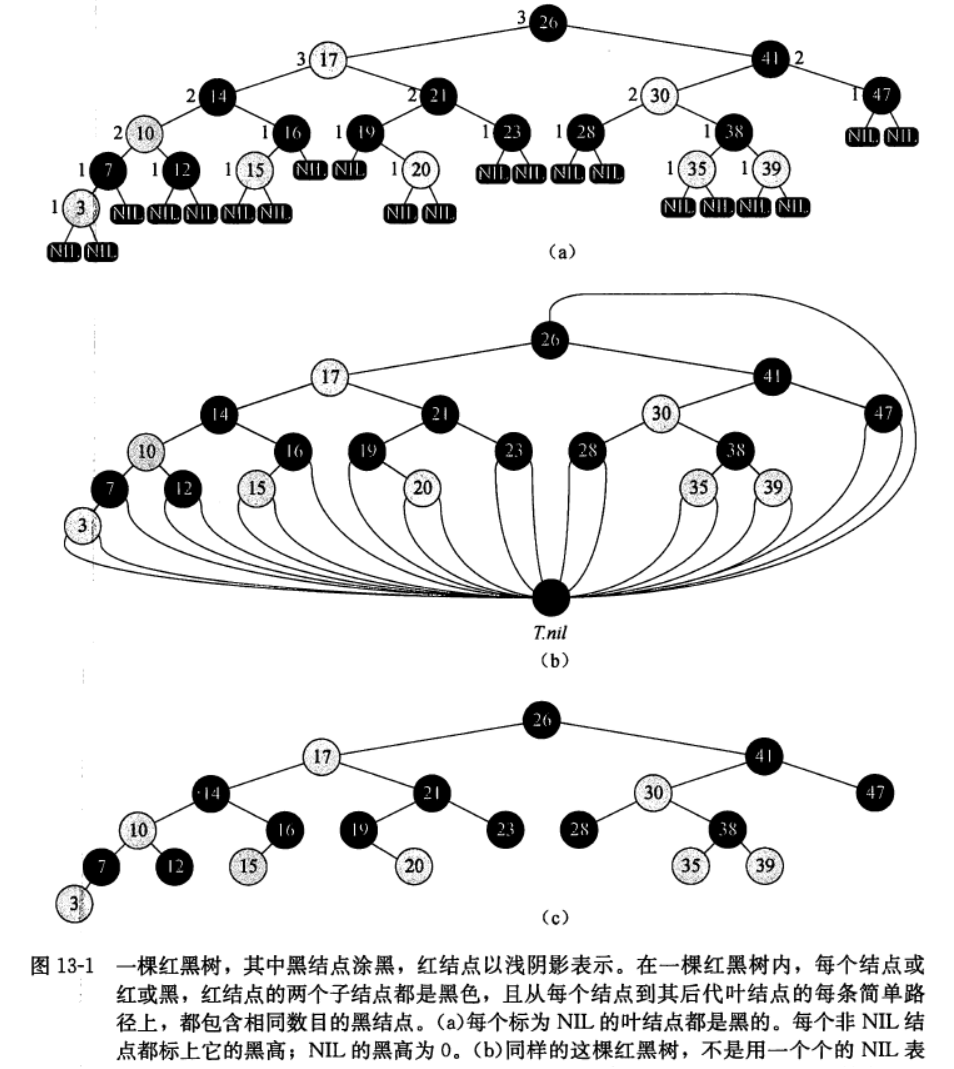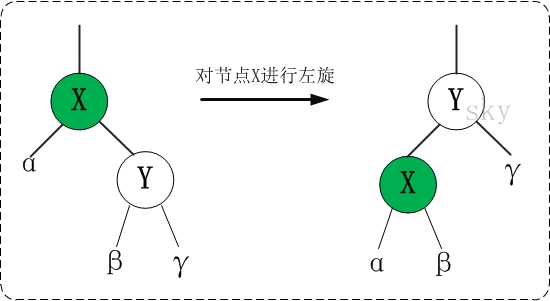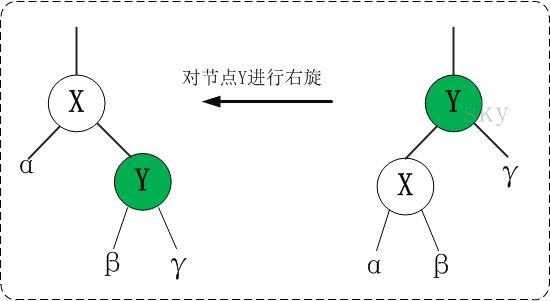红黑树原理
红黑树(Red-Black Tree,简称R-B Tree),它是一种特殊的二叉查找树。首先它满足二叉查找树的特征:任意结点结点包含的键值,大于左孩子的键值,小于右孩子的键值。
除此之外,红黑树的每个结点都有存储位来表示结点的颜色,不是红(Red)就是 黑(Black)。
红黑树的特性:
- 1.每个结点或是红色的,或是黑色的。
- 2.根结点是黑色的。
- 3.每个叶结点(NIL)是黑色的。(最后的叶结点就是空的,或者用一个哨兵替换掉所有的空结点)
- 4.如果一个结点是红色的,那么它的两个子结点都是黑色的。
- 5.对每个结点,从该结点到其所有后代叶结点的简单路径上,均包含相同数目的黑色结点。
关于它的特性,需要注意:
第一,特性 3 中的叶子结点,是为空(NIL或null)的结点
第二,特性 5 ,确保没有一条路径会比其他路径长出2倍,因而是近似平衡的。
红黑树的图如下(直接借用算法导论中的图,其中浅色的为红色,深色的为黑色):

红黑树的java代码实现
红黑树的基本操作是查找,选择,添加,删除。查找就省略了,和二叉树的查找区别不大。在添加和删除后,都会用到红黑树的旋转。因为修改红黑树之后,会破坏红黑树的性质,所以需要旋转满足这几条性质。
旋转包括两种:左旋和右旋
1.基本定义
public class RBTree<T extends Comparable<T>>{
private RBTNode<T> mRoot; //根结点
private static final boolean RED = false;
private static final boolean BLACK = true;
public class RBTNode<T extends Comparable<T>>{
boolean color; //颜色
T key; //关键字(键值)
RBTNode<T> left; //左孩子
RBTNode<T> right; //右孩子
RBTNode<T> parent; //父节点
public RBTNode(T key, boolean color, RBTNode<T> parent, RBTNode<T> left, RBTNode<T> right) {
this.key = key;
this.color = color;
this.parent = parent;
this.left = left;
this.right = right;
}
}
...
}
说明:RBTree是红黑树对应的类,RBTNode是红黑树的结点类。在RBTree中包含了根节点mRoot和红黑树的相关API。
2.左旋

对x进行左旋,意味着将x变成一个左结点。
左旋代码
/*
* 对红黑树的节点(x)进行左旋转
*
* 左旋示意图(对节点x进行左旋):
* px px
* / /
* x y
* / \ --(左旋)-. / \ #
* lx y x ry
* / \ / \
* ly ry lx ly
*
*
*/
private void leftRotate(RBTNode<T> x){
//设置x的右孩子为y
RBTNode<T> y = x.right;
//将 "y的左孩子" 设为 "x的右孩子"
//如果y的左孩子非空,将 "x" 设为 "y的左孩子的父亲"
x.right = y.left;
if(y.left != null){
y.left.parent = x;
}
//将 "x的父亲" 设为 "y的父亲"
y.parent = x.parent;
if(x.parent == null){
this.mRoot = y; //如果 "x的父亲" 是空结点,则将y设为根结点
}else{
if(x.parent.left == x){
x.parent.left = y; //如果 x是它父节点的左孩子,则将y设置为 "x的父节点的左孩子"
}else{
x.parent.right = y; //如果 x是它父节点的右孩子,则将y设置为 "x的父节点的右孩子"
}
}
// 将 “x” 设为 “y的左孩子”
y.left = x;
// 将 “x的父节点” 设为 “y”
x.parent = y;
}
3.右旋

对y进行左旋,意味着"将y变成一个右节点"。
右旋代码:
/*
* 对红黑树的节点(y)进行右旋转
*
* 右旋示意图(对节点y进行左旋):
* py py
* / /
* y x
* / \ --(右旋)-. / \ #
* x ry lx y
* / \ / \ #
* lx rx rx ry
*
*/
private void rightRotate(RBTNode<T> y) {
// 设置x是当前节点的左孩子。
RBTNode<T> x = y.left;
// 将 “x的右孩子” 设为 “y的左孩子”;
// 如果"x的右孩子"不为空的话,将 “y” 设为 “x的右孩子的父亲”
y.left = x.right;
if (x.right != null)
x.right.parent = y;
// 将 “y的父亲” 设为 “x的父亲”
x.parent = y.parent;
if (y.parent == null) {
this.mRoot = x; // 如果 “y的父亲” 是空节点,则将x设为根节点
} else {
if (y == y.parent.right)
y.parent.right = x; // 如果 y是它父节点的右孩子,则将x设为“y的父节点的右孩子”
else
y.parent.left = x; // (y是它父节点的左孩子) 将x设为“x的父节点的左孩子”
}
// 将 “y” 设为 “x的右孩子”
x.right = y;
// 将 “y的父节点” 设为 “x”
y.parent = x;
}
4.添加
将结点插入红黑树时,首先将红黑树当作一棵二叉查找树,然后将结点插入;然后将结点着色为红色,再通过“旋转和重新着色”等操作修正该树,使其成为一棵红黑树。详细步骤如下:
第一步:将红黑树当作一棵二叉查找树,将结点插入(这个简单,不展开)。
第二步:将插入的结点着色为“红色”
为什么着色为红色,而不是黑色?可以观测红黑树的5个特性,发现不会违背“特性(5)”,当然有可能违背其他特性,但只是可能,不一定会,所以遵循着违背的越少越好的原则,将插入的结点着色为红色。
第三步:通过一系列的选择或者着色等操作,使其重新成为红黑树
第二步中,将插入节点着色为"红色"之后,不会违背"特性(5)"。那它到底会违背哪些特性呢?
对于"特性(1)",显然不会违背了。因为我们已经将它涂成红色了。
对于"特性(2)",显然也不会违背。在第一步中,我们是将红黑树当作二叉查找树,然后执行的插入操作。而根据二叉查找数的特点,插入操作不会改变根节点。所以,根节点仍然是黑色。
对于"特性(3)",显然不会违背了。这里的叶子节点是指的空叶子节点,插入非空节点并不会对它们造成影响。
对于"特性(4)",是有可能违背的!
那接下来,想办法使之"满足特性(4)",就可以将树重新构造成红黑树了。
添加操作的实现代码
/*
* 将结点插入到红黑树中
*
* 参数说明:
* node 插入的结点 // 对应《算法导论》中的node
*/
private void insert(RBTNode<T> node) {
int cmp;
RBTNode<T> y = null;
RBTNode<T> x = this.mRoot;
// 1. 将红黑树当作一颗二叉查找树,将节点添加到二叉查找树中。
while (x != null) {
y = x;
cmp = node.key.compareTo(x.key);
if (cmp < 0)
x = x.left;
else
x = x.right;
}
node.parent = y;
if (y!=null) {
cmp = node.key.compareTo(y.key);
if (cmp < 0)
y.left = node;
else
y.right = node;
} else {
this.mRoot = node;
}
// 2. 设置节点的颜色为红色
node.color = RED;
// 3. 将它重新修正为一颗二叉查找树
insertFixUp(node);
}
/*
* 新建结点(key),并将其插入到红黑树中
*
* 参数说明:
* key 插入结点的键值
*/
public void insert(T key) {
RBTNode<T> node=new RBTNode<T>(key,BLACK,null,null,null);
// 如果新建结点失败,则返回。
if (node != null)
insert(node);
}
内部接口 -- insert(node)的作用是将"node"节点插入到红黑树中。
外部接口 -- insert(key)的作用是将"key"添加到红黑树中。
添加修正操作的实现代码
/*
* 红黑树插入修正函数
*
* 在向红黑树中插入节点之后(失去平衡),再调用该函数;
* 目的是将它重新塑造成一颗红黑树。
*
* 参数说明:
* node 插入的结点 // 对应《算法导论》中的z
*/
private void insertFixUp(RBTNode<T> node) {
RBTNode<T> parent, gparent;
// 若“父节点存在,并且父节点的颜色是红色”
while (((parent = parentOf(node))!=null) && isRed(parent)) {
gparent = parentOf(parent);
//若“父节点”是“祖父节点的左孩子”
if (parent == gparent.left) {
// Case 1条件:叔叔节点是红色
RBTNode<T> uncle = gparent.right;
if ((uncle!=null) && isRed(uncle)) {
setBlack(uncle);
setBlack(parent);
setRed(gparent);
node = gparent;
continue;
}
// Case 2条件:叔叔是黑色,且当前节点是右孩子
if (parent.right == node) {
RBTNode<T> tmp;
leftRotate(parent);
tmp = parent;
parent = node;
node = tmp;
}
// Case 3条件:叔叔是黑色,且当前节点是左孩子。
setBlack(parent);
setRed(gparent);
rightRotate(gparent);
} else { //若“z的父节点”是“z的祖父节点的右孩子”
// Case 1条件:叔叔节点是红色
RBTNode<T> uncle = gparent.left;
if ((uncle!=null) && isRed(uncle)) {
setBlack(uncle);
setBlack(parent);
setRed(gparent);
node = gparent;
continue;
}
// Case 2条件:叔叔是黑色,且当前节点是左孩子
if (parent.left == node) {
RBTNode<T> tmp;
rightRotate(parent);
tmp = parent;
parent = node;
node = tmp;
}
// Case 3条件:叔叔是黑色,且当前节点是右孩子。
setBlack(parent);
setRed(gparent);
leftRotate(gparent);
}
}
// 将根节点设为黑色
setBlack(this.mRoot);
}
insertFixUp(node)的作用是对应"上面所讲的第三步"。它是一个内部接口。
5.删除操作
将红黑树内的某一个节点删除。需要执行的操作依次是:首先,将红黑树当作一颗二叉查找树,将该节点从二叉查找树中删除;然后,通过"旋转和重新着色"等一系列来修正该树,使之重新成为一棵红黑树。详细描述如下:
第一步:将红黑树当作一棵二叉查找树,将结点删除
这和"删除常规二叉查找树中删除节点的方法是一样的"。分3种情况:
① 被删除节点没有儿子,即为叶节点。那么,直接将该节点删除就OK了。
② 被删除节点只有一个儿子。那么,直接删除该节点,并用该节点的唯一子节点顶替它的位置。
③ 被删除节点有两个儿子。那么,先找出它的后继节点;然后把“它的后继节点的内容”复制给“该节点的内容”;之后,删除“它的后继节点”。在这里,后继节点相当于替身,在将后继节点的内容复制给"被删除节点"之后,再将后继节点删除。这样就巧妙的将问题转换为"删除后继节点"的情况了,下面就考虑后继节点。 在"被删除节点"有两个非空子节点的情况下,它的后继节点不可能是双子非空。既然"的后继节点"不可能双子都非空,就意味着"该节点的后继节点"要么没有儿子,要么只有一个儿子。若没有儿子,则按"情况① "进行处理;若只有一个儿子,则按"情况② "进行处理。
第二步:通过“旋转和重新着色”等一系列操作修正该树,使其重新成为一棵红黑树。
因为"第一步"中删除节点之后,可能会违背红黑树的特性。所以需要通过"旋转和重新着色"来修正该树,使之重新成为一棵红黑树。
/*
* 删除结点(node),并返回被删除的结点
*
* 参数说明:
* node 删除的结点
*/
private void remove(RBTNode<T> node) {
RBTNode<T> child, parent;
boolean color;
// 被删除节点的"左右孩子都不为空"的情况。
if ( (node.left!=null) && (node.right!=null) ) {
// 被删节点的后继节点。(称为"取代节点")
// 用它来取代"被删节点"的位置,然后再将"被删节点"去掉。
RBTNode<T> replace = node;
// 获取后继节点
replace = replace.right;
while (replace.left != null)
replace = replace.left;
// "node节点"不是根节点(只有根节点不存在父节点)
if (parentOf(node)!=null) {
if (parentOf(node).left == node)
parentOf(node).left = replace;
else
parentOf(node).right = replace;
} else {
// "node节点"是根节点,更新根节点。
this.mRoot = replace;
}
// child是"取代节点"的右孩子,也是需要"调整的节点"。
// "取代节点"肯定不存在左孩子!因为它是一个后继节点。
child = replace.right;
parent = parentOf(replace);
// 保存"取代节点"的颜色
color = colorOf(replace);
// "被删除节点"是"它的后继节点的父节点"
if (parent == node) {
parent = replace;
} else {
// child不为空
if (child!=null)
setParent(child, parent);
parent.left = child;
replace.right = node.right;
setParent(node.right, replace);
}
replace.parent = node.parent;
replace.color = node.color;
replace.left = node.left;
node.left.parent = replace;
if (color == BLACK)
removeFixUp(child, parent);
node = null;
return ;
}
if (node.left !=null) {
child = node.left;
} else {
child = node.right;
}
parent = node.parent;
// 保存"取代节点"的颜色
color = node.color;
if (child!=null)
child.parent = parent;
// "node节点"不是根节点
if (parent!=null) {
if (parent.left == node)
parent.left = child;
else
parent.right = child;
} else {
this.mRoot = child;
}
if (color == BLACK)
removeFixUp(child, parent);
node = null;
}
/*
* 删除结点(z),并返回被删除的结点
*
* 参数说明:
* tree 红黑树的根结点
* z 删除的结点
*/
public void remove(T key) {
RBTNode<T> node;
if ((node = search(mRoot, key)) != null)
remove(node);
}
内部接口 -- remove(node)的作用是将"node"节点插入到红黑树中。
外部接口 -- remove(key)删除红黑树中键值为key的节点。
删除修正操作的实现代码
/*
* 红黑树删除修正函数
*
* 在从红黑树中删除插入节点之后(红黑树失去平衡),再调用该函数;
* 目的是将它重新塑造成一颗红黑树。
*
* 参数说明:
* node 待修正的节点
*/
private void removeFixUp(RBTNode<T> node, RBTNode<T> parent) {
RBTNode<T> other;
while ((node==null || isBlack(node)) && (node != this.mRoot)) {
if (parent.left == node) {
other = parent.right;
if (isRed(other)) {
// Case 1: x的兄弟w是红色的
setBlack(other);
setRed(parent);
leftRotate(parent);
other = parent.right;
}
if ((other.left==null || isBlack(other.left)) &&
(other.right==null || isBlack(other.right))) {
// Case 2: x的兄弟w是黑色,且w的俩个孩子也都是黑色的
setRed(other);
node = parent;
parent = parentOf(node);
} else {
if (other.right==null || isBlack(other.right)) {
// Case 3: x的兄弟w是黑色的,并且w的左孩子是红色,右孩子为黑色。
setBlack(other.left);
setRed(other);
rightRotate(other);
other = parent.right;
}
// Case 4: x的兄弟w是黑色的;并且w的右孩子是红色的,左孩子任意颜色。
setColor(other, colorOf(parent));
setBlack(parent);
setBlack(other.right);
leftRotate(parent);
node = this.mRoot;
break;
}
} else {
other = parent.left;
if (isRed(other)) {
// Case 1: x的兄弟w是红色的
setBlack(other);
setRed(parent);
rightRotate(parent);
other = parent.left;
}
if ((other.left==null || isBlack(other.left)) &&
(other.right==null || isBlack(other.right))) {
// Case 2: x的兄弟w是黑色,且w的俩个孩子也都是黑色的
setRed(other);
node = parent;
parent = parentOf(node);
} else {
if (other.left==null || isBlack(other.left)) {
// Case 3: x的兄弟w是黑色的,并且w的左孩子是红色,右孩子为黑色。
setBlack(other.right);
setRed(other);
leftRotate(other);
other = parent.left;
}
// Case 4: x的兄弟w是黑色的;并且w的右孩子是红色的,左孩子任意颜色。
setColor(other, colorOf(parent));
setBlack(parent);
setBlack(other.left);
rightRotate(parent);
node = this.mRoot;
break;
}
}
}
if (node!=null)
setBlack(node);
}
removeFixup(node, parent)是对应"上面所讲的第三步"。它是一个内部接口。
红黑树的完整源码
下面是红黑树实现的完整代码和相应的测试程序。
(1) 除了上面所说的"左旋"、"右旋"、"添加"、"删除"等基本操作之后,还实现了"遍历"、"查找"、"打印"、"最小值"、"最大值"、"创建"、"销毁"等接口。
(2) 函数接口大多分为内部接口和外部接口。内部接口是private函数,外部接口则是public函数。
(3) 测试代码中提供了"插入"和"删除"动作的检测开关。默认是关闭的,打开方法可以参考"代码中的说明"。建议在打开开关后,在草稿上自己动手绘制一下红黑树。
红黑树的实现文件(RBTree.java)
/**
* Java 语言: 红黑树
*
* @author skywang
* @date 2013/11/07
*/
public class RBTree<T extends Comparable<T>> {
private RBTNode<T> mRoot; // 根结点
private static final boolean RED = false;
private static final boolean BLACK = true;
public class RBTNode<T extends Comparable<T>> {
boolean color; // 颜色
T key; // 关键字(键值)
RBTNode<T> left; // 左孩子
RBTNode<T> right; // 右孩子
RBTNode<T> parent; // 父结点
public RBTNode(T key, boolean color, RBTNode<T> parent, RBTNode<T> left, RBTNode<T> right) {
this.key = key;
this.color = color;
this.parent = parent;
this.left = left;
this.right = right;
}
public T getKey() {
return key;
}
public String toString() {
return ""+key+(this.color==RED?"(R)":"B");
}
}
public RBTree() {
mRoot=null;
}
private RBTNode<T> parentOf(RBTNode<T> node) {
return node!=null ? node.parent : null;
}
private boolean colorOf(RBTNode<T> node) {
return node!=null ? node.color : BLACK;
}
private boolean isRed(RBTNode<T> node) {
return ((node!=null)&&(node.color==RED)) ? true : false;
}
private boolean isBlack(RBTNode<T> node) {
return !isRed(node);
}
private void setBlack(RBTNode<T> node) {
if (node!=null)
node.color = BLACK;
}
private void setRed(RBTNode<T> node) {
if (node!=null)
node.color = RED;
}
private void setParent(RBTNode<T> node, RBTNode<T> parent) {
if (node!=null)
node.parent = parent;
}
private void setColor(RBTNode<T> node, boolean color) {
if (node!=null)
node.color = color;
}
/*
* 前序遍历"红黑树"
*/
private void preOrder(RBTNode<T> tree) {
if(tree != null) {
System.out.print(tree.key+" ");
preOrder(tree.left);
preOrder(tree.right);
}
}
public void preOrder() {
preOrder(mRoot);
}
/*
* 中序遍历"红黑树"
*/
private void inOrder(RBTNode<T> tree) {
if(tree != null) {
inOrder(tree.left);
System.out.print(tree.key+" ");
inOrder(tree.right);
}
}
public void inOrder() {
inOrder(mRoot);
}
/*
* 后序遍历"红黑树"
*/
private void postOrder(RBTNode<T> tree) {
if(tree != null)
{
postOrder(tree.left);
postOrder(tree.right);
System.out.print(tree.key+" ");
}
}
public void postOrder() {
postOrder(mRoot);
}
/*
* (递归实现)查找"红黑树x"中键值为key的节点
*/
private RBTNode<T> search(RBTNode<T> x, T key) {
if (x==null)
return x;
int cmp = key.compareTo(x.key);
if (cmp < 0)
return search(x.left, key);
else if (cmp > 0)
return search(x.right, key);
else
return x;
}
public RBTNode<T> search(T key) {
return search(mRoot, key);
}
/*
* (非递归实现)查找"红黑树x"中键值为key的节点
*/
private RBTNode<T> iterativeSearch(RBTNode<T> x, T key) {
while (x!=null) {
int cmp = key.compareTo(x.key);
if (cmp < 0)
x = x.left;
else if (cmp > 0)
x = x.right;
else
return x;
}
return x;
}
public RBTNode<T> iterativeSearch(T key) {
return iterativeSearch(mRoot, key);
}
/*
* 查找最小结点:返回tree为根结点的红黑树的最小结点。
*/
private RBTNode<T> minimum(RBTNode<T> tree) {
if (tree == null)
return null;
while(tree.left != null)
tree = tree.left;
return tree;
}
public T minimum() {
RBTNode<T> p = minimum(mRoot);
if (p != null)
return p.key;
return null;
}
/*
* 查找最大结点:返回tree为根结点的红黑树的最大结点。
*/
private RBTNode<T> maximum(RBTNode<T> tree) {
if (tree == null)
return null;
while(tree.right != null)
tree = tree.right;
return tree;
}
public T maximum() {
RBTNode<T> p = maximum(mRoot);
if (p != null)
return p.key;
return null;
}
/*
* 找结点(x)的后继结点。即,查找"红黑树中数据值大于该结点"的"最小结点"。
*/
public RBTNode<T> successor(RBTNode<T> x) {
// 如果x存在右孩子,则"x的后继结点"为 "以其右孩子为根的子树的最小结点"。
if (x.right != null)
return minimum(x.right);
// 如果x没有右孩子。则x有以下两种可能:
// (01) x是"一个左孩子",则"x的后继结点"为 "它的父结点"。
// (02) x是"一个右孩子",则查找"x的最低的父结点,并且该父结点要具有左孩子",找到的这个"最低的父结点"就是"x的后继结点"。
RBTNode<T> y = x.parent;
while ((y!=null) && (x==y.right)) {
x = y;
y = y.parent;
}
return y;
}
/*
* 找结点(x)的前驱结点。即,查找"红黑树中数据值小于该结点"的"最大结点"。
*/
public RBTNode<T> predecessor(RBTNode<T> x) {
// 如果x存在左孩子,则"x的前驱结点"为 "以其左孩子为根的子树的最大结点"。
if (x.left != null)
return maximum(x.left);
// 如果x没有左孩子。则x有以下两种可能:
// (01) x是"一个右孩子",则"x的前驱结点"为 "它的父结点"。
// (01) x是"一个左孩子",则查找"x的最低的父结点,并且该父结点要具有右孩子",找到的这个"最低的父结点"就是"x的前驱结点"。
RBTNode<T> y = x.parent;
while ((y!=null) && (x==y.left)) {
x = y;
y = y.parent;
}
return y;
}
/*
* 对红黑树的节点(x)进行左旋转
*
* 左旋示意图(对节点x进行左旋):
* px px
* / /
* x y
* / \ --(左旋)-. / \ #
* lx y x ry
* / \ / \
* ly ry lx ly
*
*
*/
private void leftRotate(RBTNode<T> x) {
// 设置x的右孩子为y
RBTNode<T> y = x.right;
// 将 “y的左孩子” 设为 “x的右孩子”;
// 如果y的左孩子非空,将 “x” 设为 “y的左孩子的父亲”
x.right = y.left;
if (y.left != null)
y.left.parent = x;
// 将 “x的父亲” 设为 “y的父亲”
y.parent = x.parent;
if (x.parent == null) {
this.mRoot = y; // 如果 “x的父亲” 是空节点,则将y设为根节点
} else {
if (x.parent.left == x)
x.parent.left = y; // 如果 x是它父节点的左孩子,则将y设为“x的父节点的左孩子”
else
x.parent.right = y; // 如果 x是它父节点的左孩子,则将y设为“x的父节点的左孩子”
}
// 将 “x” 设为 “y的左孩子”
y.left = x;
// 将 “x的父节点” 设为 “y”
x.parent = y;
}
/*
* 对红黑树的节点(y)进行右旋转
*
* 右旋示意图(对节点y进行左旋):
* py py
* / /
* y x
* / \ --(右旋)-. / \ #
* x ry lx y
* / \ / \ #
* lx rx rx ry
*
*/
private void rightRotate(RBTNode<T> y) {
// 设置x是当前节点的左孩子。
RBTNode<T> x = y.left;
// 将 “x的右孩子” 设为 “y的左孩子”;
// 如果"x的右孩子"不为空的话,将 “y” 设为 “x的右孩子的父亲”
y.left = x.right;
if (x.right != null)
x.right.parent = y;
// 将 “y的父亲” 设为 “x的父亲”
x.parent = y.parent;
if (y.parent == null) {
this.mRoot = x; // 如果 “y的父亲” 是空节点,则将x设为根节点
} else {
if (y == y.parent.right)
y.parent.right = x; // 如果 y是它父节点的右孩子,则将x设为“y的父节点的右孩子”
else
y.parent.left = x; // (y是它父节点的左孩子) 将x设为“x的父节点的左孩子”
}
// 将 “y” 设为 “x的右孩子”
x.right = y;
// 将 “y的父节点” 设为 “x”
y.parent = x;
}
/*
* 红黑树插入修正函数
*
* 在向红黑树中插入节点之后(失去平衡),再调用该函数;
* 目的是将它重新塑造成一颗红黑树。
*
* 参数说明:
* node 插入的结点 // 对应《算法导论》中的z
*/
private void insertFixUp(RBTNode<T> node) {
RBTNode<T> parent, gparent;
// 若“父节点存在,并且父节点的颜色是红色”
while (((parent = parentOf(node))!=null) && isRed(parent)) {
gparent = parentOf(parent);
//若“父节点”是“祖父节点的左孩子”
if (parent == gparent.left) {
// Case 1条件:叔叔节点是红色
RBTNode<T> uncle = gparent.right;
if ((uncle!=null) && isRed(uncle)) {
setBlack(uncle);
setBlack(parent);
setRed(gparent);
node = gparent;
continue;
}
// Case 2条件:叔叔是黑色,且当前节点是右孩子
if (parent.right == node) {
RBTNode<T> tmp;
leftRotate(parent);
tmp = parent;
parent = node;
node = tmp;
}
// Case 3条件:叔叔是黑色,且当前节点是左孩子。
setBlack(parent);
setRed(gparent);
rightRotate(gparent);
} else { //若“z的父节点”是“z的祖父节点的右孩子”
// Case 1条件:叔叔节点是红色
RBTNode<T> uncle = gparent.left;
if ((uncle!=null) && isRed(uncle)) {
setBlack(uncle);
setBlack(parent);
setRed(gparent);
node = gparent;
continue;
}
// Case 2条件:叔叔是黑色,且当前节点是左孩子
if (parent.left == node) {
RBTNode<T> tmp;
rightRotate(parent);
tmp = parent;
parent = node;
node = tmp;
}
// Case 3条件:叔叔是黑色,且当前节点是右孩子。
setBlack(parent);
setRed(gparent);
leftRotate(gparent);
}
}
// 将根节点设为黑色
setBlack(this.mRoot);
}
/*
* 将结点插入到红黑树中
*
* 参数说明:
* node 插入的结点 // 对应《算法导论》中的node
*/
private void insert(RBTNode<T> node) {
int cmp;
RBTNode<T> y = null;
RBTNode<T> x = this.mRoot;
// 1. 将红黑树当作一颗二叉查找树,将节点添加到二叉查找树中。
while (x != null) {
y = x;
cmp = node.key.compareTo(x.key);
if (cmp < 0)
x = x.left;
else
x = x.right;
}
node.parent = y;
if (y!=null) {
cmp = node.key.compareTo(y.key);
if (cmp < 0)
y.left = node;
else
y.right = node;
} else {
this.mRoot = node;
}
// 2. 设置节点的颜色为红色
node.color = RED;
// 3. 将它重新修正为一颗二叉查找树
insertFixUp(node);
}
/*
* 新建结点(key),并将其插入到红黑树中
*
* 参数说明:
* key 插入结点的键值
*/
public void insert(T key) {
RBTNode<T> node=new RBTNode<T>(key,BLACK,null,null,null);
// 如果新建结点失败,则返回。
if (node != null)
insert(node);
}
/*
* 红黑树删除修正函数
*
* 在从红黑树中删除插入节点之后(红黑树失去平衡),再调用该函数;
* 目的是将它重新塑造成一颗红黑树。
*
* 参数说明:
* node 待修正的节点
*/
private void removeFixUp(RBTNode<T> node, RBTNode<T> parent) {
RBTNode<T> other;
while ((node==null || isBlack(node)) && (node != this.mRoot)) {
if (parent.left == node) {
other = parent.right;
if (isRed(other)) {
// Case 1: x的兄弟w是红色的
setBlack(other);
setRed(parent);
leftRotate(parent);
other = parent.right;
}
if ((other.left==null || isBlack(other.left)) &&
(other.right==null || isBlack(other.right))) {
// Case 2: x的兄弟w是黑色,且w的俩个孩子也都是黑色的
setRed(other);
node = parent;
parent = parentOf(node);
} else {
if (other.right==null || isBlack(other.right)) {
// Case 3: x的兄弟w是黑色的,并且w的左孩子是红色,右孩子为黑色。
setBlack(other.left);
setRed(other);
rightRotate(other);
other = parent.right;
}
// Case 4: x的兄弟w是黑色的;并且w的右孩子是红色的,左孩子任意颜色。
setColor(other, colorOf(parent));
setBlack(parent);
setBlack(other.right);
leftRotate(parent);
node = this.mRoot;
break;
}
} else {
other = parent.left;
if (isRed(other)) {
// Case 1: x的兄弟w是红色的
setBlack(other);
setRed(parent);
rightRotate(parent);
other = parent.left;
}
if ((other.left==null || isBlack(other.left)) &&
(other.right==null || isBlack(other.right))) {
// Case 2: x的兄弟w是黑色,且w的俩个孩子也都是黑色的
setRed(other);
node = parent;
parent = parentOf(node);
} else {
if (other.left==null || isBlack(other.left)) {
// Case 3: x的兄弟w是黑色的,并且w的左孩子是红色,右孩子为黑色。
setBlack(other.right);
setRed(other);
leftRotate(other);
other = parent.left;
}
// Case 4: x的兄弟w是黑色的;并且w的右孩子是红色的,左孩子任意颜色。
setColor(other, colorOf(parent));
setBlack(parent);
setBlack(other.left);
rightRotate(parent);
node = this.mRoot;
break;
}
}
}
if (node!=null)
setBlack(node);
}
/*
* 删除结点(node),并返回被删除的结点
*
* 参数说明:
* node 删除的结点
*/
private void remove(RBTNode<T> node) {
RBTNode<T> child, parent;
boolean color;
// 被删除节点的"左右孩子都不为空"的情况。
if ( (node.left!=null) && (node.right!=null) ) {
// 被删节点的后继节点。(称为"取代节点")
// 用它来取代"被删节点"的位置,然后再将"被删节点"去掉。
RBTNode<T> replace = node;
// 获取后继节点
replace = replace.right;
while (replace.left != null)
replace = replace.left;
// "node节点"不是根节点(只有根节点不存在父节点)
if (parentOf(node)!=null) {
if (parentOf(node).left == node)
parentOf(node).left = replace;
else
parentOf(node).right = replace;
} else {
// "node节点"是根节点,更新根节点。
this.mRoot = replace;
}
// child是"取代节点"的右孩子,也是需要"调整的节点"。
// "取代节点"肯定不存在左孩子!因为它是一个后继节点。
child = replace.right;
parent = parentOf(replace);
// 保存"取代节点"的颜色
color = colorOf(replace);
// "被删除节点"是"它的后继节点的父节点"
if (parent == node) {
parent = replace;
} else {
// child不为空
if (child!=null)
setParent(child, parent);
parent.left = child;
replace.right = node.right;
setParent(node.right, replace);
}
replace.parent = node.parent;
replace.color = node.color;
replace.left = node.left;
node.left.parent = replace;
if (color == BLACK)
removeFixUp(child, parent);
node = null;
return ;
}
if (node.left !=null) {
child = node.left;
} else {
child = node.right;
}
parent = node.parent;
// 保存"取代节点"的颜色
color = node.color;
if (child!=null)
child.parent = parent;
// "node节点"不是根节点
if (parent!=null) {
if (parent.left == node)
parent.left = child;
else
parent.right = child;
} else {
this.mRoot = child;
}
if (color == BLACK)
removeFixUp(child, parent);
node = null;
}
/*
* 删除结点(z),并返回被删除的结点
*
* 参数说明:
* tree 红黑树的根结点
* z 删除的结点
*/
public void remove(T key) {
RBTNode<T> node;
if ((node = search(mRoot, key)) != null)
remove(node);
}
/*
* 销毁红黑树
*/
private void destroy(RBTNode<T> tree) {
if (tree==null)
return ;
if (tree.left != null)
destroy(tree.left);
if (tree.right != null)
destroy(tree.right);
tree=null;
}
public void clear() {
destroy(mRoot);
mRoot = null;
}
/*
* 打印"红黑树"
*
* key -- 节点的键值
* direction -- 0,表示该节点是根节点;
* -1,表示该节点是它的父结点的左孩子;
* 1,表示该节点是它的父结点的右孩子。
*/
private void print(RBTNode<T> tree, T key, int direction) {
if(tree != null) {
if(direction==0) // tree是根节点
System.out.printf("%2d(B) is root\n", tree.key);
else // tree是分支节点
System.out.printf("%2d(%s) is %2d's %6s child\n", tree.key, isRed(tree)?"R":"B", key, direction==1?"right" : "left");
print(tree.left, tree.key, -1);
print(tree.right,tree.key, 1);
}
}
public void print() {
if (mRoot != null)
print(mRoot, mRoot.key, 0);
}
}
红黑树的测试文件(RBTreeTest.java)
/**
* Java 语言: 二叉查找树
*
* @author skywang
* @date 2013/11/07
*/
public class RBTreeTest {
private static final int a[] = {10, 40, 30, 60, 90, 70, 20, 50, 80};
private static final boolean mDebugInsert = false; // "插入"动作的检测开关(false,关闭;true,打开)
private static final boolean mDebugDelete = false; // "删除"动作的检测开关(false,关闭;true,打开)
public static void main(String[] args) {
int i, ilen = a.length;
RBTree<Integer> tree=new RBTree<Integer>();
System.out.printf("== 原始数据: ");
for(i=0; i<ilen; i++)
System.out.printf("%d ", a[i]);
System.out.printf("\n");
for(i=0; i<ilen; i++) {
tree.insert(a[i]);
// 设置mDebugInsert=true,测试"添加函数"
if (mDebugInsert) {
System.out.printf("== 添加节点: %d\n", a[i]);
System.out.printf("== 树的详细信息: \n");
tree.print();
System.out.printf("\n");
}
}
System.out.printf("== 前序遍历: ");
tree.preOrder();
System.out.printf("\n== 中序遍历: ");
tree.inOrder();
System.out.printf("\n== 后序遍历: ");
tree.postOrder();
System.out.printf("\n");
System.out.printf("== 最小值: %s\n", tree.minimum());
System.out.printf("== 最大值: %s\n", tree.maximum());
System.out.printf("== 树的详细信息: \n");
tree.print();
System.out.printf("\n");
// 设置mDebugDelete=true,测试"删除函数"
if (mDebugDelete) {
for(i=0; i<ilen; i++)
{
tree.remove(a[i]);
System.out.printf("== 删除节点: %d\n", a[i]);
System.out.printf("== 树的详细信息: \n");
tree.print();
System.out.printf("\n");
}
}
// 销毁二叉树
tree.clear();
}
}
参考资料
真的很感谢这位博主的解析,让我等也能窥探红黑树的代码魅力。
1.http://www.cnblogs.com/skywang12345/p/3624343.html

